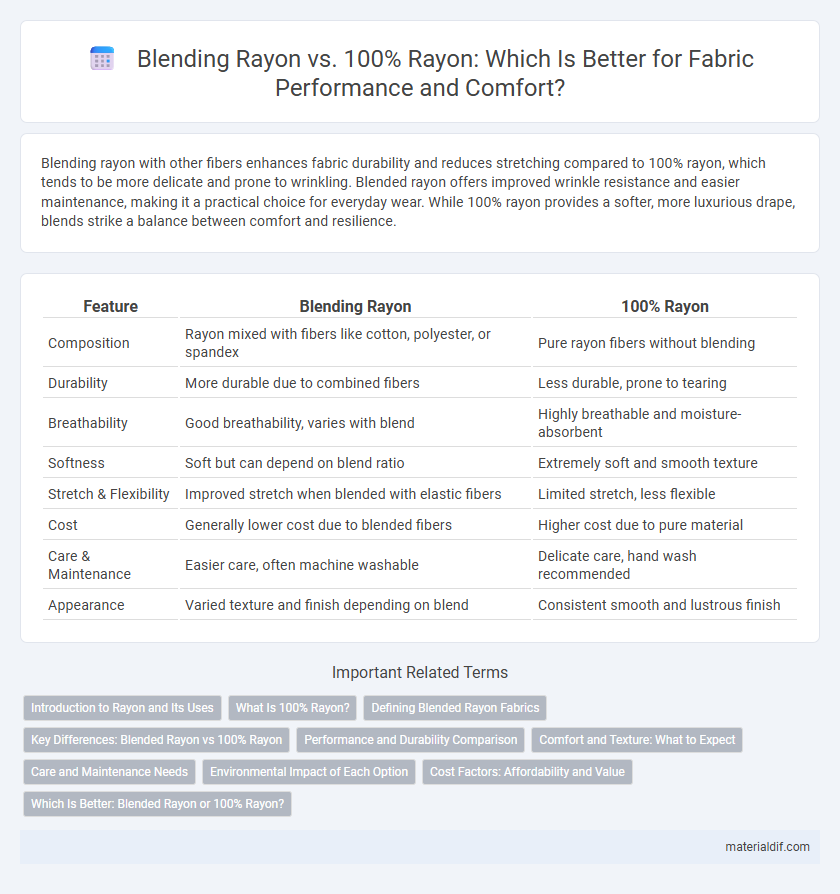Blending rayon with other fibers enhances fabric durability and reduces stretching compared to 100% rayon, which tends to be more delicate and prone to wrinkling. Blended rayon offers improved wrinkle resistance and easier maintenance, making it a practical choice for everyday wear. While 100% rayon provides a softer, more luxurious drape, blends strike a balance between comfort and resilience.
Table of Comparison
| Feature | Blending Rayon | 100% Rayon |
|---|---|---|
| Composition | Rayon mixed with fibers like cotton, polyester, or spandex | Pure rayon fibers without blending |
| Durability | More durable due to combined fibers | Less durable, prone to tearing |
| Breathability | Good breathability, varies with blend | Highly breathable and moisture-absorbent |
| Softness | Soft but can depend on blend ratio | Extremely soft and smooth texture |
| Stretch & Flexibility | Improved stretch when blended with elastic fibers | Limited stretch, less flexible |
| Cost | Generally lower cost due to blended fibers | Higher cost due to pure material |
| Care & Maintenance | Easier care, often machine washable | Delicate care, hand wash recommended |
| Appearance | Varied texture and finish depending on blend | Consistent smooth and lustrous finish |
Introduction to Rayon and Its Uses
Rayon, a semi-synthetic fiber made from regenerated cellulose, offers a versatile fabric choice prized for its softness and breathability. Blending rayon with other fibers enhances durability, wrinkle resistance, and cost-effectiveness, making it ideal for diverse applications like apparel, upholstery, and home textiles. In contrast, 100% rayon garments provide a luxurious drape and moisture-wicking properties but require more delicate care due to their tendency to wrinkle and lose strength when wet.
What Is 100% Rayon?
100% Rayon is a fabric made entirely from regenerated cellulose fibers derived from natural sources like wood pulp, offering a soft, breathable, and smooth texture that mimics natural fibers such as cotton or silk. Unlike blended rayon fabrics, which combine rayon with other fibers like polyester or cotton to enhance durability and wrinkle resistance, 100% rayon provides superior moisture absorption and comfort but may require more delicate care to prevent shrinking or stretching. Understanding the composition of 100% rayon helps consumers choose fabrics that prioritize natural feel and breathability over blended performance features.
Defining Blended Rayon Fabrics
Blended rayon fabrics combine rayon fibers with other materials such as cotton, polyester, or spandex to enhance durability, stretch, and moisture-wicking properties. These blends improve fabric performance by maintaining rayon's softness and breathability while increasing strength and reducing wrinkling compared to 100% rayon. Selecting blended rayon fabrics offers a balance of comfort, longevity, and ease of care, making them ideal for versatile apparel applications.
Key Differences: Blended Rayon vs 100% Rayon
Blended rayon fabrics combine rayon fibers with other materials like cotton or polyester, enhancing durability, wrinkle resistance, and color retention compared to 100% rayon. While 100% rayon offers superior softness, breathability, and a luxurious drape, it tends to wrinkle easily and requires delicate care. The choice between blended rayon and 100% rayon hinges on desired fabric performance, maintenance preferences, and end-use applications.
Performance and Durability Comparison
Blending rayon with fibers like polyester or cotton enhances performance by improving moisture-wicking, wrinkle resistance, and tensile strength compared to 100% rayon, which tends to be more prone to stretching and shrinking. The durability of blended rayon fabrics is superior due to the added resilience of synthetic or natural fibers, resulting in longer-lasting garments that maintain shape and color after multiple washes. In contrast, 100% rayon offers a softer feel and better breathability but requires more delicate care to prevent damage and reduce wear over time.
Comfort and Texture: What to Expect
Blending rayon with other fibers enhances durability and wrinkle resistance while maintaining its soft, smooth texture, resulting in improved comfort and ease of care. 100% rayon offers a breathable, silky feel with excellent moisture absorption, making it ideal for lightweight, comfortable garments that drape well. Expect blended rayon fabrics to balance the luxurious softness of pure rayon with added strength and flexibility for everyday wear.
Care and Maintenance Needs
Blended rayon fabrics often require less delicate care compared to 100% rayon, as blending with synthetic fibers like polyester enhances durability and reduces shrinkage risk. While 100% rayon demands gentle hand washing or dry cleaning to prevent damage from water and agitation, blended rayon allows for more flexible washing options, including machine washes on gentle cycles. Both types benefit from air drying and avoiding high heat to maintain fabric integrity and prevent premature wear.
Environmental Impact of Each Option
Blending rayon with other fibers reduces the environmental footprint by decreasing the amount of water and chemicals required compared to producing 100% rayon, which demands extensive resource use and results in significant waste. 100% rayon manufacturing often involves high emissions of carbon disulfide, a toxic chemical harmful to ecosystems and human health. Choosing blended rayon fabrics supports sustainability by lowering pollution levels and conserving natural resources.
Cost Factors: Affordability and Value
Blending rayon with other fibers reduces production costs by lowering the amount of pure rayon needed, making the fabric more affordable compared to 100% rayon. Blended rayon fabrics often offer enhanced durability and wrinkle resistance, increasing their overall value for cost-conscious consumers. Despite a slightly lower purity, blending maintains a balance between affordability and the soft, breathable qualities associated with rayon.
Which Is Better: Blended Rayon or 100% Rayon?
Blended rayon combines rayon fibers with other materials like cotton or polyester to enhance durability, breathability, and wrinkle resistance, making it more versatile for everyday wear compared to 100% rayon. 100% rayon offers superior softness and a luxurious drape but tends to wrinkle easily and may require more delicate care. Choosing between blended rayon and 100% rayon depends on the desired balance between comfort, durability, and maintenance needs.
Blending Rayon vs 100% Rayon Infographic

 materialdif.com
materialdif.com